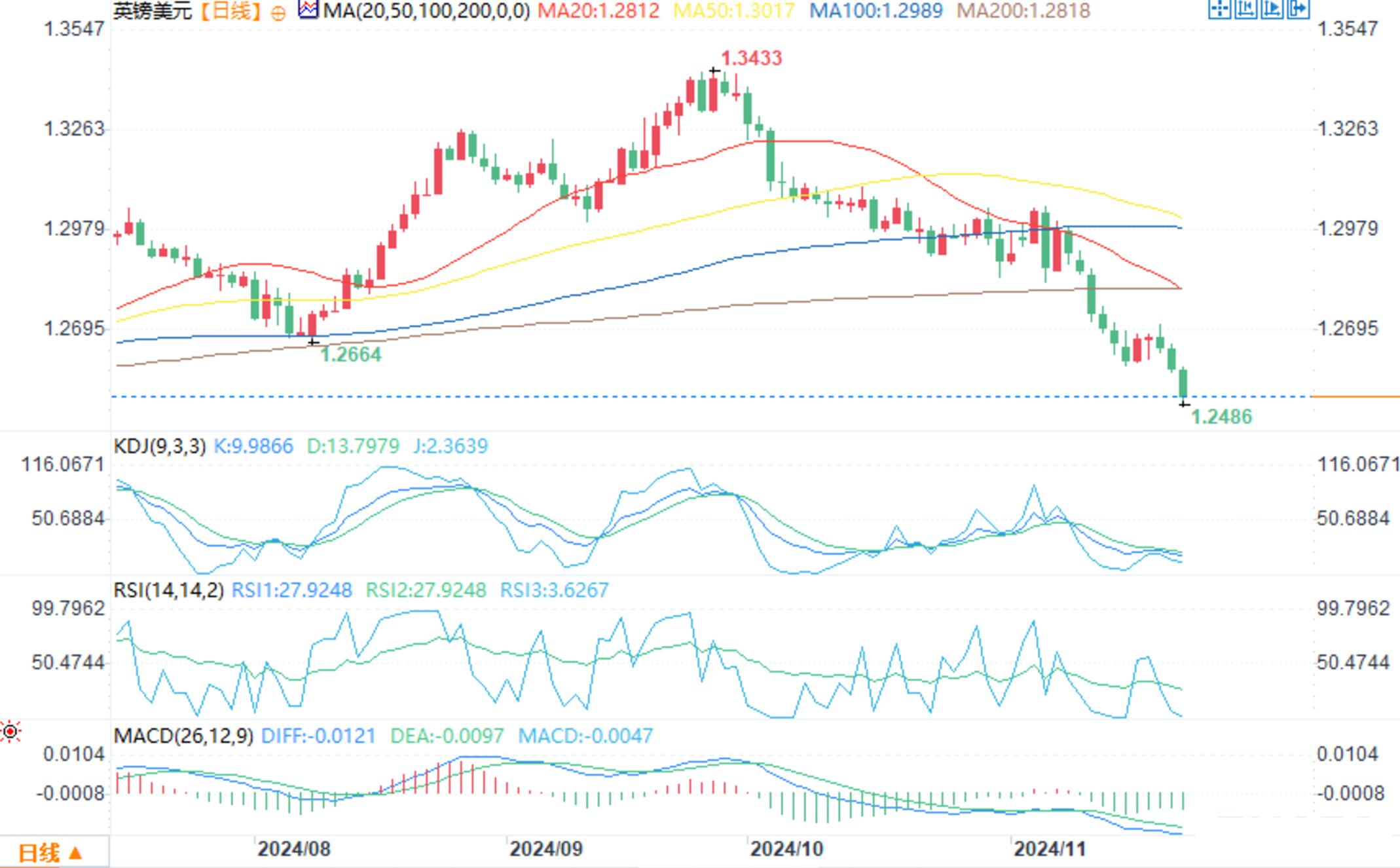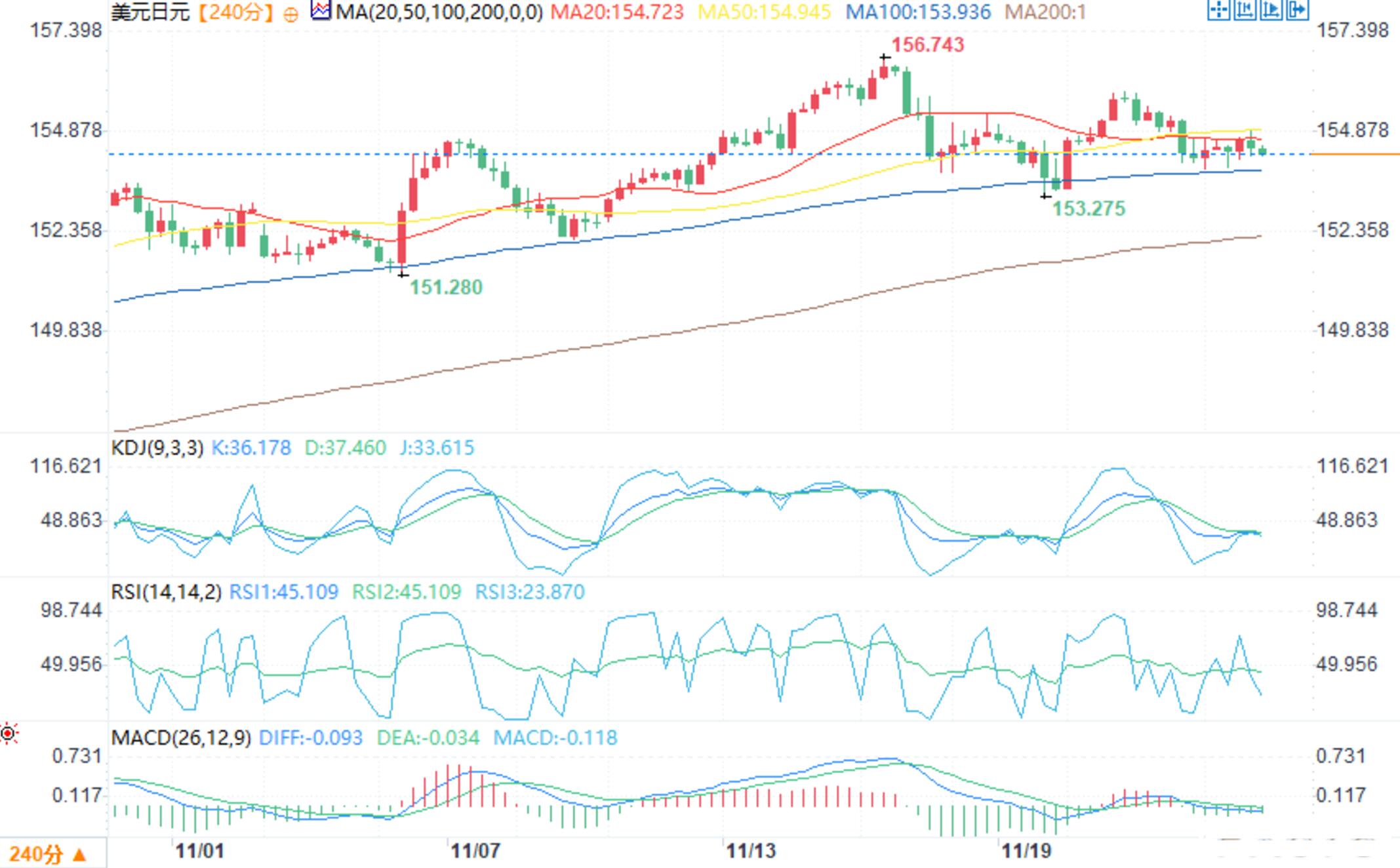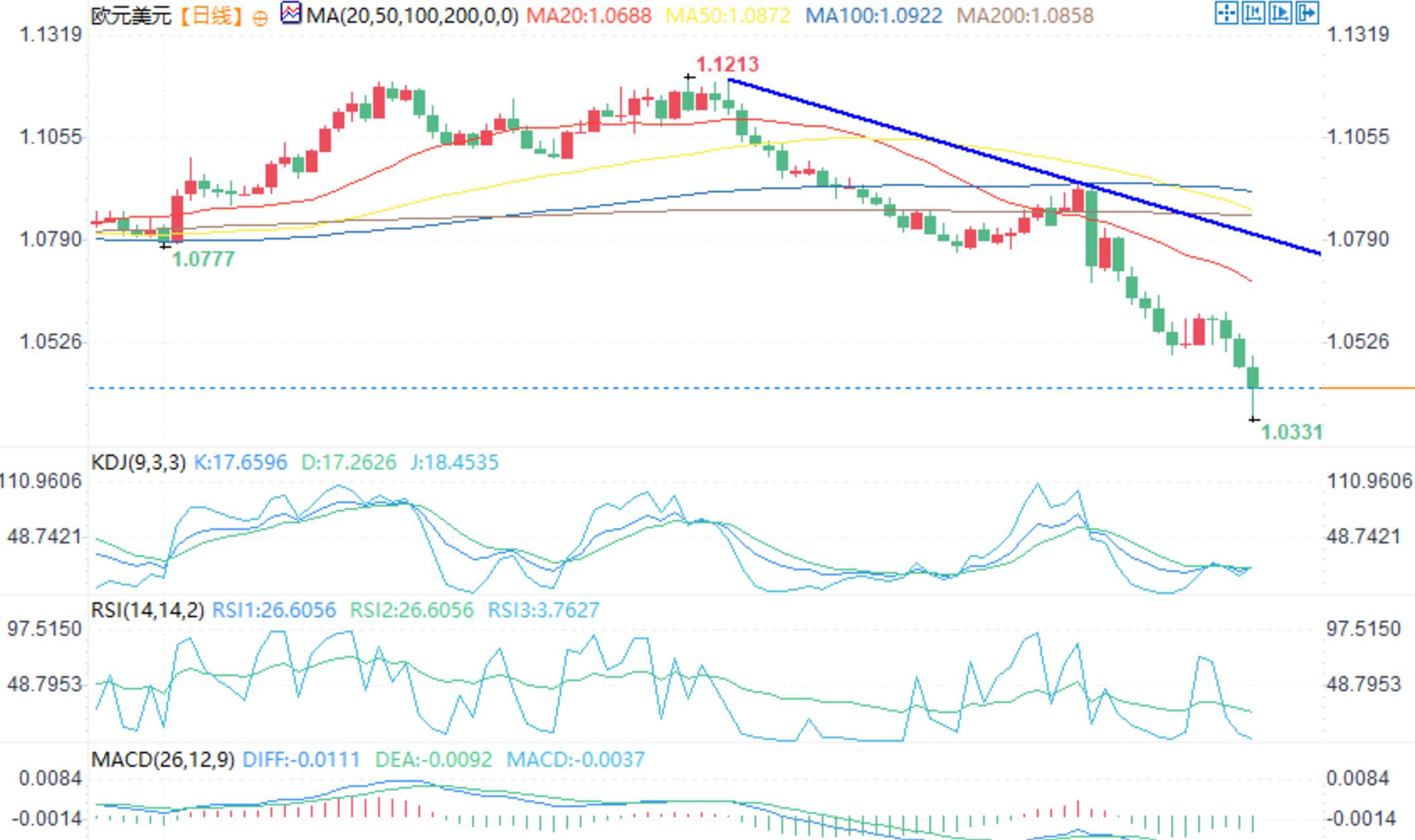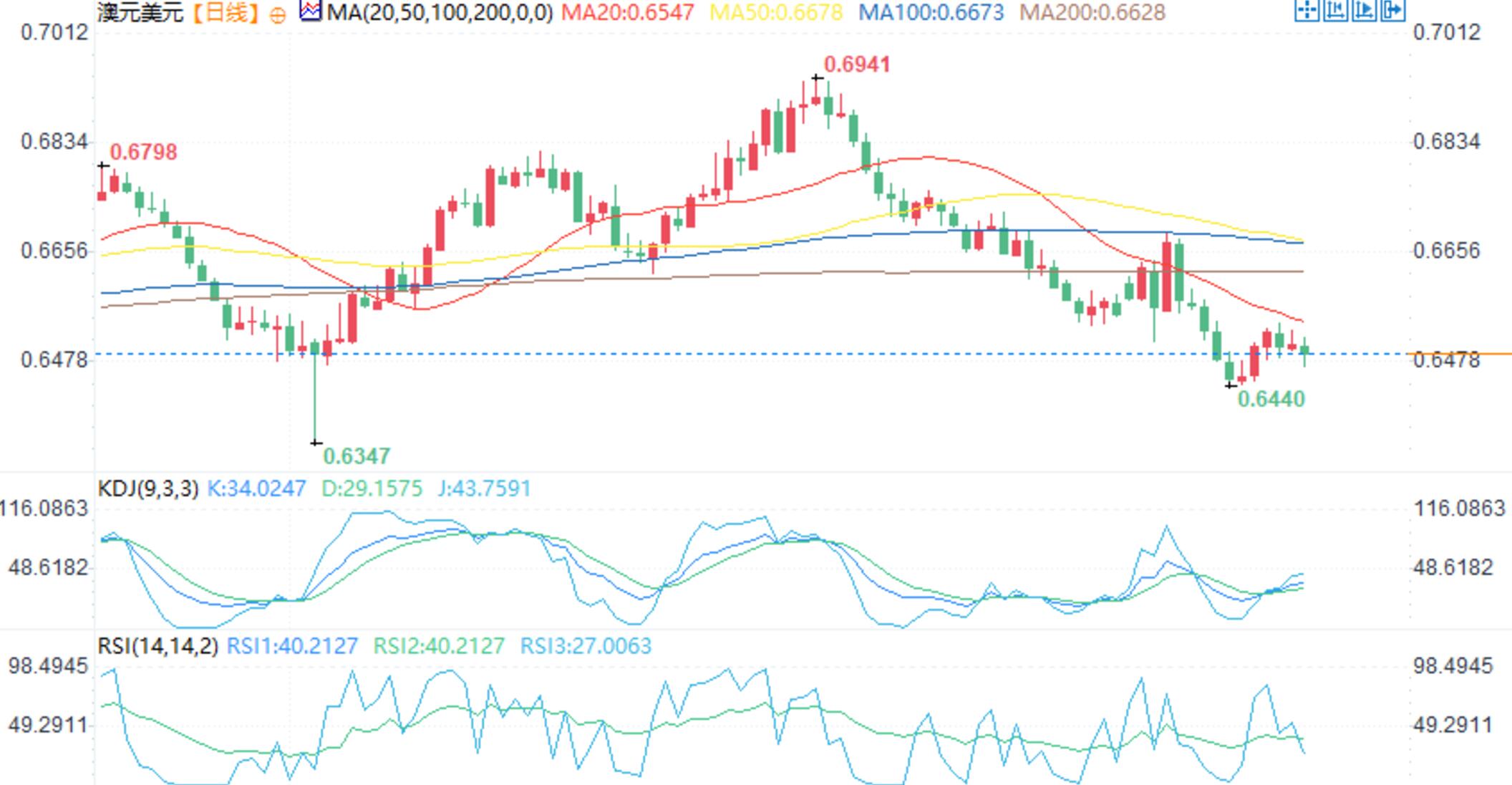Technical analysis of GBP/USD, USD/JPY, EUR/USD, AUD/USD on November 22nd
On Friday (November 22) during the European trading session, the US dollar index rose and closed at 107.4886, an increase of 0.40%. The following is an analysis of four currency pairs: GBP/USD, USD/JPY, EUR/USD, and AUD/USD.
GBP/USD remains below 1.2600

GBP/USD daily chart
The GBP/USD exchange rate fell to around 1.2550, marking its third consecutive trading day of decline and hitting a six-month low.
The retail sales in the UK fell faster than expected in October, and the pound faced a significant sell-off. The key indicator for measuring consumer spending, retail sales, decreased by 0.7% compared to last month. In September, sales slightly increased by 0.1%, a decrease from the previously reported 0.3%. Retail sales increased by 2.4% year-on-year, lower than the expected 3.4% and the previously released 3.2% (revised downward from 3.9%).
Given that multiple short-term to long-term moving averages (EMAs) are tilting downwards, the outlook for the GBP/USD pair has turned bearish.
On the 14th, the Relative Strength Index (RSI) was in the range of 20-40, indicating a strong bearish trend.
On the downside, GBP/USD is expected to find a buffer around the May low of 1.2446. On the upside side, the high point around 1.2720 on November 20th will become a key resistance.
USD/JPY consolidation: Will there be a new upward trend?

4-hour chart of USD/JPY
The US dollar/Japanese yen began to correct downwards, falling below 156.00. The US dollar/Japanese yen is trading below the support level of 155.50, entering a short-term bearish zone.
On the 4-hour chart, the US dollar/Japanese yen fell below the support level of 154.20 and tested the 100 simple moving average. The currency pair is stable above 154.00 and currently far above the 200 simple moving average.
The currency pair has formed a low point at 153.90 and is currently trading within a range. On the upward trend, the currency pair may face resistance around 154.90.
The first major resistance level is around 155.30. On the 4-hour chart, a major contraction triangle has also formed at the resistance level of 155.30. If the closing price is above 155.30, it may set the tone for the next uptrend.
The next major resistance level may be 155.85, above which the price may climb towards the resistance level of 156.50. Any further increase could push the USD/JPY towards 158.00.
On the downward trend, the immediate support level is around 154.00. The next key support level is around 153.60. Any further losses could push the currency pair towards levels of 153.00 or even 152.40 in the short term.
EUR/USD falls to two-year low

EUR/USD daily chart
During the European trading session, after the preliminary report of the HCOB Eurozone Purchasing Managers' Index (PMI) was released, the index fell below 1.0400, approaching a two-year low. The report shows an unexpected contraction in overall business activity. The Eurozone Composite PMI fell to 48.1, while economists expect economic data to manage to stay near the 50.0 boundary line.
The euro/dollar is breaking through downwards and falling to a new low in 2024 in the process. Last week's low of 1.04956 has been breached, and for short-term traders seeking more downward momentum, it is now close to risk. Staying below is more bearish.
The euro/dollar continued its downward trend, falling to a two-year low below 1.0400 on Friday, following the psychological support of falling below 1.0500 the day before.
With the decline of all short-term to long-term moving averages (EMAs), the euro/dollar may witness more declines. In the long run, the euro has recovered from weakness.
The relative strength index (RSI) fluctuated in the bearish range of 20-40 on the 14th, adding evidence of further weakness in the near future.
On the downside, the euro/dollar bottomed at 1.0332 on Friday. If this level is not maintained, the euro/dollar can find a buffer around the support of 1.0300. On the other hand, the psychological level of 1.0500 and the high of 1.0600 on November 20th will be the key resistance for euro bulls.
AUD/USD fluctuates within a range during calm trading

AUD/USD daily chart
This week, the Australian dollar/US dollar exchange rate was largely unaffected by fluctuations in the US dollar and remained relatively stable at the 0.6500 level, slightly higher than the recent three-month low of 0.6439.
Due to the fact that the Relative Strength Index (RSI) points to the bearish zone below 50 and the random oscillation indicator is set to a negative reversal, there is currently not much evidence to suggest that investors have a strong willingness to buy. In addition, the short-term price trend is clearly running within the bearish channel and below the simple moving average (SMA), reflecting pessimistic sentiment.
If it breaks through the 20 day moving average and the previous support trend line of 0.6555, it may encounter direct resistance at the 38.2% Fibonacci retracement level on the channel and the sustained bearish trend, which is also consistent with the flattening of the 200 day moving average. If the price continues to rise, bulls may attempt to break through the previous high and the downtrend line above the 50% Fibonacci level of 0.6690.
On the contrary, if the price falls below the support of 0.6440, the decline may extend to the key support trend line connecting the low points of 2022 to 2024, which is 0.6380. If the price continues to decline, it may trigger the euro to fall towards the bottom of 0.6270-0.6300. If this support is still broken, the focus will shift to the bottom of 0.6169 in 2022.
Tips:This page came from Internet, which is not standing for FXCUE opinions of this website.
Statement:Contact us if the content violates the law or your rights
